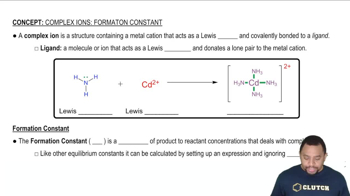Here are the essential concepts you must grasp in order to answer the question correctly.
Equilibrium in Chemical Reactions
Equilibrium in chemical reactions refers to the state where the rates of the forward and reverse reactions are equal, resulting in constant concentrations of reactants and products. In this context, understanding how the concentrations of Zn2+ and NH3 interact at equilibrium is crucial for determining the final concentration of Zn2+ in the solution.
Recommended video:
Chemical Equilibrium Concepts
Complex Ion Formation
Complex ion formation occurs when metal ions, such as Zn2+, interact with ligands like NH3 to form a complex. This process can significantly affect the concentration of free metal ions in solution, as the formation of complexes reduces the amount of free Zn2+ available, which is essential for calculating the equilibrium concentration.
Recommended video:
Complex Ions and Formation Constant
Le Chatelier's Principle
Le Chatelier's Principle states that if a system at equilibrium is disturbed, the system will adjust to counteract the disturbance and restore a new equilibrium. In this scenario, changes in concentration of NH3 or Zn(NO3)2 will shift the equilibrium position, impacting the concentration of Zn2+ ions in the solution.
Recommended video:





